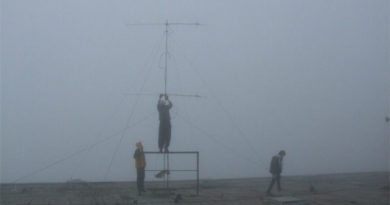Small antenna system for Oscar 40
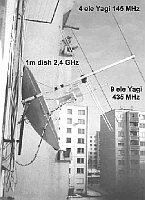
Introduction
The AMSAT Oscar satellite is currently in operation 40 (pre-launching Phase 3D), which was the largest satellite project in the history of amateur radio satellites. Oscar 40 has the so-called. matrix transponder, i.e, that it is possible to select different combinations of uplink (input) a downlink (exit). After a few months of operation it seems, that the main satellite mode will be the US – uplink on the U band (435 MHz) and downlink in the S band (2,4 GHz). Most active stations also use this combination. In addition to the uplink to 435 MHz is still possible in the L band (1296 MHz) and in the V band (145 MHz) and downlink in the K band (24 GHz), however, US mode is currently the most enabled. Therefore, I decided to build a station for this mode. The parameters of the AO-40 satellite satellite transmitter allow ground stations to use antennas with relatively small dimensions.
In my article I will describe simple antennas for bands 435 MHz transmitting antenna 9 elemental Yagi and na 2,4 GHz receiving antenna dish with helical irradiator. This set has also proven itself in practice. Similar antennas are used by many active stations around the world. In this article, I did not want to describe in detail the complete antenna system from A to Z , but I wanted to give ideas and inspiration to experiment with the Oscar 40.
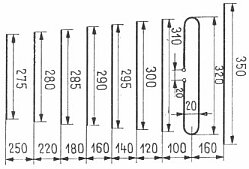
Transmitting antenna on 435 MHz
Make an average good antenna for 435 MHz should not be a problem for the amateur radio either – beginner. We will need aluminum or duralumin material for this, as well as some basic tools (meter, pílka, files, drill, drills, vice…). We will use for this band 9 Yagi linear polarization element antenna, according to an antenna book by Karel Rothammel. [ 1.] Of course this is the minimum, more demanding can make and use longer antennas. The best solution is to use Yagi cross antennas – however, production and use (grip, rotation…) such antennas is much more demanding, therefore, a smaller antenna will suffice for the first attempts – in our case 9 elemental. You can see the antenna in Fig.1. – the total length is just over 1m, so it will not be a problem to mount the antenna behind the reflector. We use square duralumin material 20 as a beam×20 mm or a tube with a diameter of 20 mm. We cut the rafter so, to leave a sufficient margin behind the reflector to hold the antenna. All elements are made of material 4-6 mm and are mounted on the boom uninsulated. The antenna according to the original source has a gain 11,5 dB, anteroposterior ratio 19 dB, horizontal beam angle 44 degrees and the vertical beam angle 48 degrees. The antenna impedance is 240 Ohm, therefore, for powering with a coaxial cable, it is necessary to use a balun transformer. Calculation, the procedure and method of execution was described in RŽ 6/98 [ 2. ] and also in other literature. We close the supply point watertight in a plastic box. We test the finished antenna (at least SWR and others if possible…).
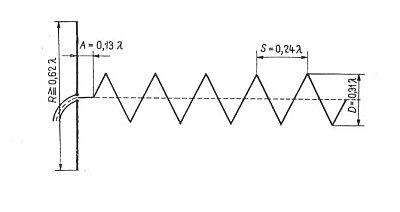
Receiving antenna on 2,4 GHz
Construction of the antenna for the band 2,4 GHz will no longer be easy either, as for 70 cm. The first step is to choose a suitable antenna for reception in this band. When we look, what that in the world what everything is used for, so the conclusion is clear: most stations use a dish. In addition to parabolic antennas, helix antennas are also used (helical antennas), loop, Yagi and their modifications. However, on 2,4 The GHz dimensions of the classic Yagi and loop antennas are already so small, that their execution is difficult. A helix is also possible. However, we want such an antenna, which will have sufficient profit and a relatively simple mechanical construction. Such an antenna will clearly be a dish. We don't have to laboriously produce a parabolic mirror at home – various dishes with a diameter of 60 cm to 1 m can be used for satellite and MMDS television. For simplicity, we will work with the central dish – the use of offset dishes is also possible, they are used by a number of stations. Older central dish with diameter 90 cm and 1m can be bought for a few hundred crowns, when we are lucky, so even for less (hi…). I use a dish with a diameter of 1m.
Second question, the thing we have to investigate is the irradiator. In the literature we can find descriptions of various irradiators for this band. I have personally manufactured and tested several types and solutions (according to DB6NT, DK1VC, OE9PMJ, etc.). However, they have linear polarization and are more suitable for normal operation. For satellite operation, a feed with circular polarization would be better: at EME stations the irradiator according to VE4MA is very widespread and popular and at Czech EME stations (OK1DFC, OK1CA, OK1UWA) also feed with septum-polarization switch. Many amateurs use a helix irradiator in satellite systems. There are several design solutions, for example. according to G3RUH, G6LVB… etc.. [ 3.] etc.. Helix irradiator has several advantages, for example.: the already mentioned circular polarization, simple construction and assembly. For simplicity and mechanical simplicity, I chose a helix irradiator – so we are determined: we will use the center dish (with an average of about 90 cm – more profit…) and a helix irradiator and a directly connected converter as one structural unit.
After obtaining the dish, we dismantle all structural elements, which we will not use – so we are left with only a bare parabolic mirror. We will make a suitable fit – everyone has to deal with it individually as much as possible. You can see one of the possible solutions in fig. 2.:
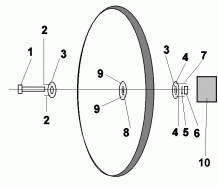 1. long screw at least M8
1. long screw at least M8
2. M4 screws – M5
3. ring made of 3mm Al
4. holes for screws pos. 2.
5. flat and flexible washers
6. nut M8 for screw pos. 1.
7. washers and nuts for screws pos. 2.
8. screw hole pos. 1. on the parable
9. holes for screws pos. 2. on the parable
10. counterweight
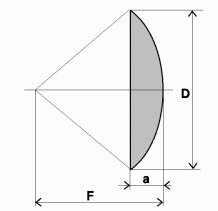 We measure the exact diameter and depth, according to which we calculate the focus. – obr.3.
We measure the exact diameter and depth, according to which we calculate the focus. – obr.3.
Formula used: F = D2/16a
where D – is the diameter of the parabola
a – is the depth of the parabolic mirror in the axis
We can use various articles and publications in the calculation, for example. in RZ 4/99 lähde: Zdenka OK1DFC, [ 4.] etc.. After calculating the focal length, let's start with the design of the irradiator.: first we calculate the diameter of the reflector, radiator and the distance between the threads. We use formulas:
Reflector diameter R = 0,62 lambda
Distance of the radiator from the reflector A = 3900 / f [cm, MHz] or A = 0,13 lambda
Distance between threads S = 7200 / f [cm, MHz] or S = 0,24 lambda
Emitter diameter D = 9300 / f [cm, MHz ] or D = 0,31 lambda
You can see the basic dimensions of the helix antenna in Fig.4 (that).
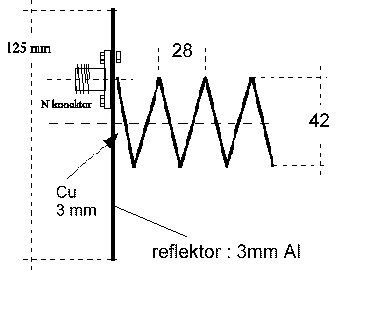
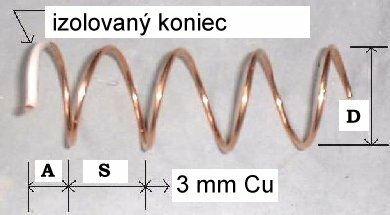
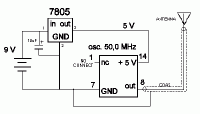 But when we don't want to count, so in the literature (e.g.. according to OK2AQK, [ 5.] or G3RUH) or on the Internet [ 6.] we find the already calculated and described helix irradiator. You can see such an irradiator in FIG. 5. On the picture. 6. you see the finished radiator of the helix irradiator: the material is Cu wire of diameter 3 mm – I used welding consumables (average 3,15 mm) and so on, that full length (1 m) I wound it on a mandrel of suitable diameter. The number of threads will be the maximum 4 to 5. When turning, pay attention to the sense of rotation: the signal from the satellite has a clockwise polarization, – e.g.. we would wind the helix antenna clockwise, but for the irradiator it must be the opposite, then counterclockwise. We make the reflector from 2 mm thick aluminum sheet. We drill three holes on the reflector, offset by o 120 degrees – for three consoles, which will hold the radiator over the parabolic mirror – holes are also drilled for the parabolic mirror on the holding brackets. We make consoles from Al logs 8 mm diameter – cut to the required length (we will leave 50 – 100 mm reserve), we cut M8 threads, and bend as needed. We make and install the clamps of the converter and radiator covers. Drill a hole for the connector on the reflector – individually according to the mechanical dimensions of the converter – the aperture is not likely to be in the geometric center of the reflector. We choose the type of connector on the irradiator accordingly, that what connector we have on the converter: I have an N socket on the converter (female), so I mounted an N plug on the radiator (male). After attaching the connector to the reflector to the middle (alive) contact cause radiator (HB9CV PMR). Of course, we will take care of it in a suitable way, so that it does not touch the reflector by any chance (resp. inanimate part) – the best way is to turn a suitable Teflon liner, but when we don't have a chance, so just thread a PVC tube on the Cu wire. Then set the helical radiator as follows, so that the center is in line with the center of the reflector. Fix the radiator in the connector with a suitable glue. Attach the finished irradiator to the dish (to the focus according to our calculation) and we try. This can be individual depending on the converter used, but in my case it looked like this: as MF receiver I use Yaesu FT 290R transceiver with range 144,0 to 148,0 MHz. After connecting the converter data on tcvr 144,0 MHz coincides with the actual received frequency 2400,0 MHz. From a crystal oscillator 50,0 MHz (which you buy for a few crowns, or you get from an old computer motherboard) I made a small one “beacon” according to FIG. 7. 48. the harmonic of the crystal oscillator falls on the frequency 2400,0 MHz, what I can already accept. When we bring the antenna of the small lighthouse closer to the irradiator for approx. 1 cm, Yes for 2400,0 MHz (then on tcvr 144,0 MHz), we should hear whistling. [ 7.] Then we will try to capture the signal from the satellite. After testing, when everything is fine, so we can continue with the surface treatment and attaching the covers. Acrylic spray is suitable for surface treatment and a plastic container is suitable as a cover to cover the converter, or sheet metal (I used an empty body sealant package). To cover the radiator – irradiator, we must use a plastic container (PVC).
But when we don't want to count, so in the literature (e.g.. according to OK2AQK, [ 5.] or G3RUH) or on the Internet [ 6.] we find the already calculated and described helix irradiator. You can see such an irradiator in FIG. 5. On the picture. 6. you see the finished radiator of the helix irradiator: the material is Cu wire of diameter 3 mm – I used welding consumables (average 3,15 mm) and so on, that full length (1 m) I wound it on a mandrel of suitable diameter. The number of threads will be the maximum 4 to 5. When turning, pay attention to the sense of rotation: the signal from the satellite has a clockwise polarization, – e.g.. we would wind the helix antenna clockwise, but for the irradiator it must be the opposite, then counterclockwise. We make the reflector from 2 mm thick aluminum sheet. We drill three holes on the reflector, offset by o 120 degrees – for three consoles, which will hold the radiator over the parabolic mirror – holes are also drilled for the parabolic mirror on the holding brackets. We make consoles from Al logs 8 mm diameter – cut to the required length (we will leave 50 – 100 mm reserve), we cut M8 threads, and bend as needed. We make and install the clamps of the converter and radiator covers. Drill a hole for the connector on the reflector – individually according to the mechanical dimensions of the converter – the aperture is not likely to be in the geometric center of the reflector. We choose the type of connector on the irradiator accordingly, that what connector we have on the converter: I have an N socket on the converter (female), so I mounted an N plug on the radiator (male). After attaching the connector to the reflector to the middle (alive) contact cause radiator (HB9CV PMR). Of course, we will take care of it in a suitable way, so that it does not touch the reflector by any chance (resp. inanimate part) – the best way is to turn a suitable Teflon liner, but when we don't have a chance, so just thread a PVC tube on the Cu wire. Then set the helical radiator as follows, so that the center is in line with the center of the reflector. Fix the radiator in the connector with a suitable glue. Attach the finished irradiator to the dish (to the focus according to our calculation) and we try. This can be individual depending on the converter used, but in my case it looked like this: as MF receiver I use Yaesu FT 290R transceiver with range 144,0 to 148,0 MHz. After connecting the converter data on tcvr 144,0 MHz coincides with the actual received frequency 2400,0 MHz. From a crystal oscillator 50,0 MHz (which you buy for a few crowns, or you get from an old computer motherboard) I made a small one “beacon” according to FIG. 7. 48. the harmonic of the crystal oscillator falls on the frequency 2400,0 MHz, what I can already accept. When we bring the antenna of the small lighthouse closer to the irradiator for approx. 1 cm, Yes for 2400,0 MHz (then on tcvr 144,0 MHz), we should hear whistling. [ 7.] Then we will try to capture the signal from the satellite. After testing, when everything is fine, so we can continue with the surface treatment and attaching the covers. Acrylic spray is suitable for surface treatment and a plastic container is suitable as a cover to cover the converter, or sheet metal (I used an empty body sealant package). To cover the radiator – irradiator, we must use a plastic container (PVC).
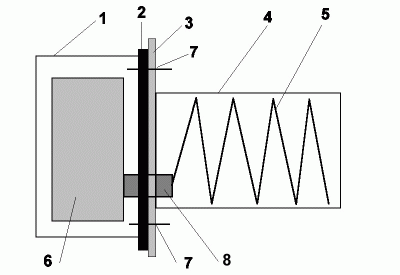
You can see the mechanical construction of the irradiator in Fig.8. :
1. converter cover
2. rubber sealing ring
3. reflector
4. radiator cover (of plastic)
5. radiator
6. converter
7. mounting holes
8. N connector (or plug)
After assembling the irradiator, we check everything again and we have the dish ready for assembly.
Antenna mounting – mechanical construction
This will fix the small system, so that we have the opportunity to experiment and that the power cables are as short as possible. We can solve the rotation easily – manually. The apparent motion of the satellite is slow, therefore, it is enough, when we direct the antennas after 1-1 throw. A simple tripod is also suitable for experiments, or a window holder. My solution is as follows: my satellite antenna system is on the roof with AZ / EL remote rotation, but for several reasons I didn't want to mount the dish upstairs (more than 30 m long lead, limited possibility of experimentation, etc.), therefore, I mounted a small system on the window frame, which I can rotate manually in both planes. A small system consists of an antenna 4 el Yagi pre 2m, and from said antennas 9 el Yagi na 70 cm and 1m parabola on 13 cm. This small system will find application when working via FO-20 and FO-29 satellites, but also as a replacement or second antenna system.

The arrangement and mechanical construction of the system is shown in Fig.9.:
1. antenna position on 145 MHz
2. horizontal boom for antennas (rotates vertically in pos. 4. )
3. mechanism for fixing the bar pos. 2.
4. T - shaped welded tubes (rotates horizontally in the oven pos. 7. )
5. parabola position on 2,4 GHz
6. antenna position on 435 MHz
7. steel tube
8. mechanism for fixing pipes pos.4.
9. console (consoles) for wall mounting, resp. window frame
This solution is simple, but it is not ideal: satellite traffic is limited to the orbital section only, which antennas “vidia”.
Conclusion
Of course, the small system described is not a tip, but for the first steps and even for normal operation it will suffice. I know, that an SSB / CW transmitter with sufficient power for 70 cm is hardly available for the average amateur – about converter to 13 cm I'm not even talking, but still there are possibilities to get simple, but usable devices – e.g.. simple transverter 2m / 70cm, redesigned MMDS converters, etc.. To local FM converter, or a packet node is easier to reach than a satellite transponder, but good connections will compensate us for our efforts, which are truly an experience in the UHF / SHF bands even then, when we know, that these are connections only through the transmitter at a distance of about 50 000 km from us. You can also find photos of the described antennas on my website: www.host.om7aq.sk or www.qsl.net/om7aq. Thanks to Zdenek OK1DFC for cooperation and help.
Literature
[1] Karl Rothammel: antenna book
[2] DL6WU antennas on 435 MHz, Production of a folded dipole (On the radio 6/98)
[3] http://www.ultimatecharger.com/dish.html
[4] Zdeněk Samek, OK1DFC: Calculation, design and construction of satellite dishes (On the radio 4/99)
[5] Miroslav Kasal, OK2AQK: S-band satellite signal receiver (Amateur radio 1995/1,2)
[6] http://www.g6lvb.com a http://www.moon-bounce.com/sband.html
[7] Amateur satellites (On the radio 4/02) a web VE2ZAZ http://www3.sympatico.ca/b.zauhar/SigSourc/SigSourc.htm
Zoltán Gyetvai OM7AQ
gye@isternet.sk



